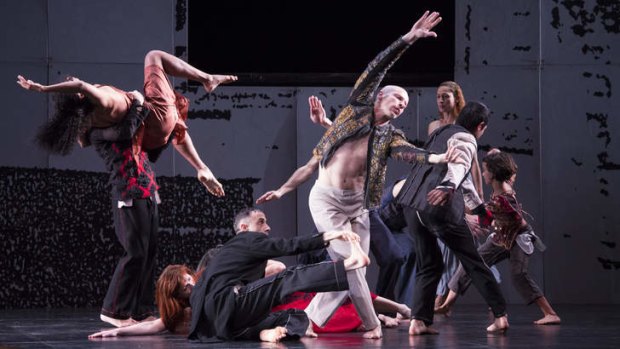By Jill Sykes
DIDO AND AENEAS
Lyric Theatre, January 16

A scene from Henry Purcell's Dido and Aeneas performed during the 2014 Sydney Festival.Credit: Jamie Williams
Until Jan 21
The underwater "dancing" in Dido & Aeneas has been given so much publicity that it is a relief to report that it only occupies the first 10 minutes of the 90-minute show. It is engaging, with up to six performers swimming gracefully around a huge tank that empties from about armpit height to ankle depth.
But it is only swimming, with some close encounters that might suggest the love theme of the opera and, amusingly, a thrashing roll in the lower depths that was reminiscent of the spinning barrel "waves" beloved of baroque opera designers.
After the tank is pushed into the wings, the real dancing takes over. And it is a delight. The vitality and liquidity of movement, for which Sasha Waltz and Guests is renowned, drives the action in close partnership with Purcell's music.
The opera may come from the 17th century but the barefoot dance is pure 21st, drawing on today's freedom of movement that can do almost anything and pick up references wherever it wishes – including, if I read it correctly, some of the courtly mannerisms of the opera's birthright transformed.
Each role is allotted a singer and a dancer – or more than one, in the case of Dido. Her agonising over her love for Aeneas is represented by two dancers – Yael Schnell and Michal Mualem – whose entangled bodies illustrate the conflict within a single character.
Watching them and listening to the singing Dido, Aurore Ugolin, is intriguing. The movement is such an intense expression of passion and despair that I had to rein back my expectations to the more subtle communication of the voice. Except at the end, when the singing of Dido's lament with both Dido figures behind identical veils of hair, allows the singer to take over.
It is not that I found a clash between dancing and singing elements, which Sasha Waltz has brought together in significant sections of the production where singers and dancers move as one – right down to rolling around the floor in their undies. It is just that they are undeniably different forms of expression.
The dance for dancers alone is powerfully performed and engrossing in its ebb and flow across the stage, using every fraction of the space available. It is often surprising for placement of performers, unconventional partnering, changes of dynamics and striking ensembles in which tableaux spring into shape from nowhere.
The final separation of the lovers (with Virgis Puodziunas and Reuben Willcox as the dance and song Aeneas respectively) is incredibly dramatic and moving, leaving an indelible impression.
To read and share your reviews of Sydney Festival shows go to smh.com.au/sydfest